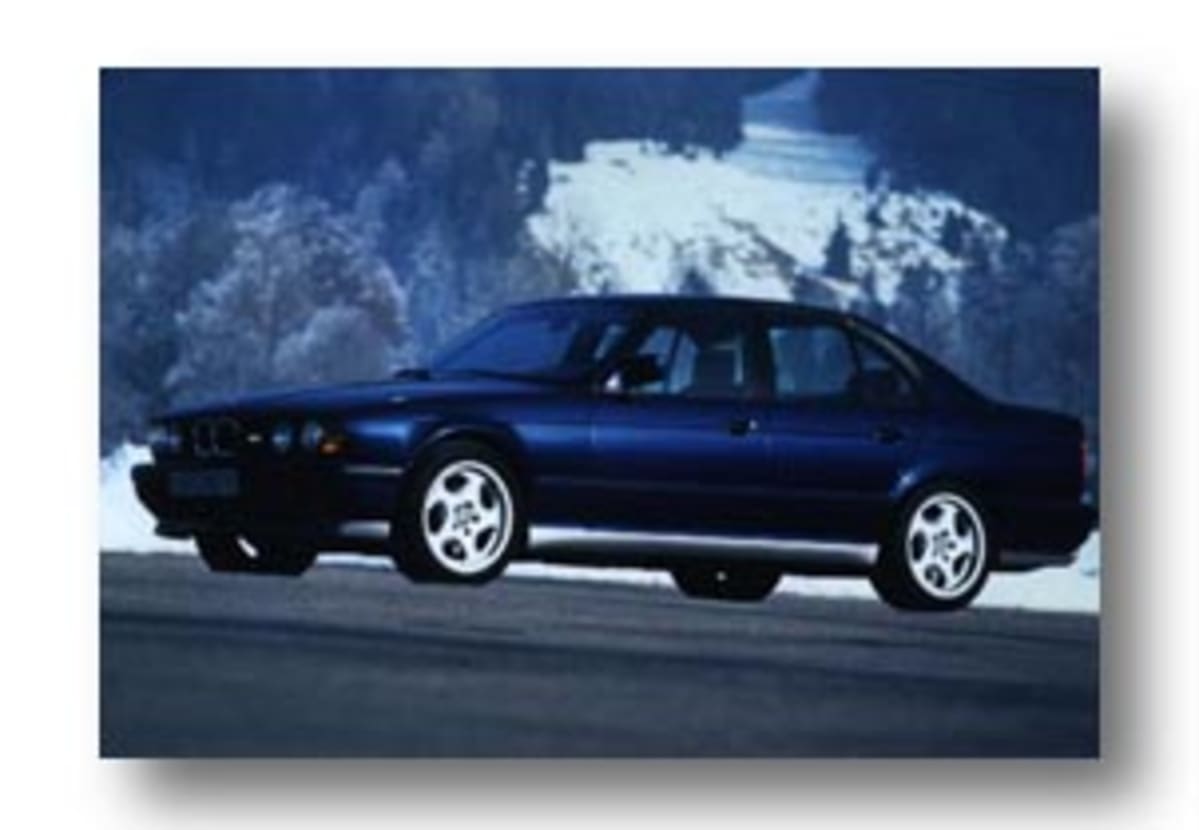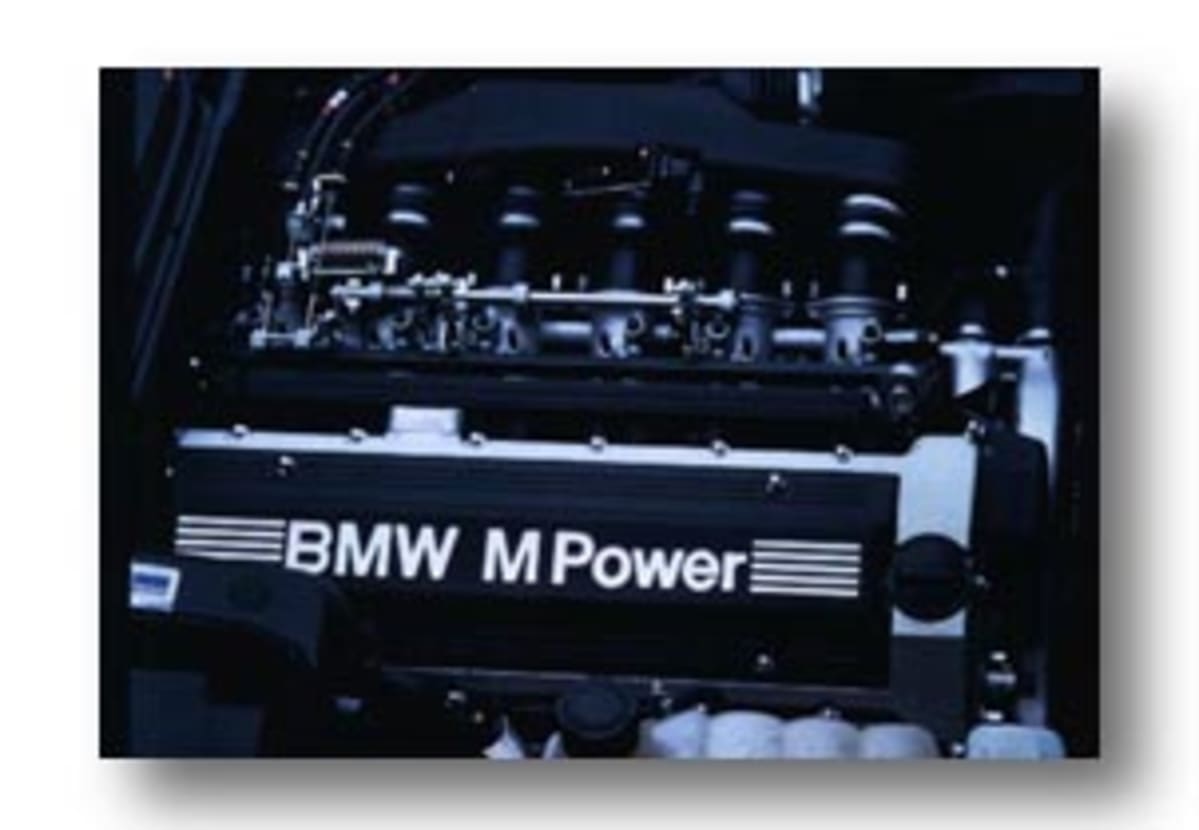BMW M5: A Modest Proposal
Published on Mon, Jan 1, 1990
By: Len Frank
Len Frank wrote about BMW’s E34 generation of the M5, which was produced from September 1988 to August 1995, and powered by the S38 in-line six engine.

BMW has been making inline six cylinder engines forever—in a couple of years it will have been sixty years since they produced their first—and around here that qualifies as forever. They are about as identified with inline sixes as Ford was with V-8s, or VW was with flat fours.
Even before their first six they had a car with independent rear suspension. The i.r.s. was of that type, that Teutonic attempt at humor, the swing axle—very independent.
BMW’s first modern independent rear suspension was used on the 600—a car they’d probably just as soon forget about now. The 600 was a sort of two door Isetta, one door in the front (like a phone booth), one door on the right side, all pushed around by a cut-rate version of the motorcycle boxer twin. A funny little quasi-car, but those were desperate times (late ‘fifties) in Munich.
In fact times remained perilous for the Bayerische Motoren Werke until they introduced the New Class cars (abandoning both their prewar notions of what the world wanted and the postwar minimalist transportation modules). That was about twenty years after the end of WWII.
The New Class cars (1500, 1600, 1800, TI, tilux, TISA, etc.) put the blue and white roundel into some sort of mainstream. They found themselves producing the kind of cars that VW should have been producing, cars for an improving economy, cars the world really bought. They weren’t the first sports sedans, but they defined “sports sedan.”

An overnight success after only 35 years.
BMW was so encouraged by their success with four cylinders that they couldn’t resist going back to six. About five years after the first of the New Class cars, BMW, with the engineering leadership of Alex von Falkenhausen, introduced a larger car to compete directly with mid-sized Mercedes. There were two engine sizes—2500 and 2800.
The 2500/2800s were not exactly successful in the U.S. There were quality problems (wind noise, rust, electrics) carburetion and driveability due to the new U.S. smog regs, problems with brakes, with durability, with automatic transmissions. Most important, they were also more expensive than their reputations allowed them to be.
Another little quirk began to show: trailing throttle oversteer (ttos). Most simply put, ttos gets you suddenly sideways when lifting the throttle (due to cowardice, excess understeer, or false prudence) in the middle of a corner. I have had it explained to me in great detail that ttos is part of the BMW handling philosophy.
There are all manner of vehicle dynamics and control functions that have a real place in the world of automotive enthusiasm. Big-time rally cars, for instance, are intentionally unstable, throttle-steering helped make cars like Cobras and old Corvettes legendary, older thoroughbred racing cars mounted the gas pedal between the clutch and brake, drivers in the ‘twenties and ‘thirties who had grown up with non-synchro gearboxes felt themselves handicapped by the new E-Z-to-shift trannies which required use of the clutch…
The problem is that ttos, like all of the other anomalies, was really only useful to a miniscule minority of the world’s drivers (Stirling Moss always claimed that he liked oversteer at 150 mph—there was only one S. Moss.), and that minority was not buying the 2500/2800, or the much improved and less expensive Bavaria that followed, or the more expensive and still more improved 3.0S that finished off the series.
There were other adventures in those sixes and the ones that followed that had nothing to do with handling: crack-prone cylinder heads, thermal reactors, Zenith carbs, the Eta engine, the diesel—all there to prove that every silver lining has a dark cloud wrapped around it.
This whole preamble is only there to set off the new M5. If you car about real supercars (as opposed to semi-roadable freaks) you’ve already read more about the M5 than is probably good for you, especially if you can’t afford one. Most of us can’t.
What is there to dislike about the M5? It has a slow shift from first to second, the trick M-sport wheels are too easily damaged against curbs (I didn’t, but I fear for them) and they make the car look as it’s wearing whitewalls. Heaven forbid.
What is there to like about the M5? Everything else.
The engine feels like it’s going to run forever, will pull from less than 1000 rpm even in fifth. When you finally get beyond proving that you can drive it that way, it will get you arrested in any of the fifty states without getting half way through third gear. Great stuff. “Wonderful” is understatement when applied to the M5.
Where did the ttos go? The handling is stable (but not to excess—a really stable car won’t turn at all), predictable, confidence inspiring. The only doubt that I have is about the owners—most of them won’t have the capability or sensitivity to appreciate the car. It will corner faster, transition better, stop more quickly, turn in better, trail-brake better, than all but about six of its lucky owners will ever be able to experience unless, of course, they let their instructors demonstrate for them on their annual refresher pilgrimages to Skip Barber/Bob Bondurant, et.al.
The only thing that keeps me from telling you that the M5 is the world’s best sports sedan/supercar is the Mercedes-Benz 500E. I have driven that as much as possible but never in proximity to the M5, and, as in most cases, dumb numbers don’t even begin to tell the story. At this point let me suggest that this all be settled by giving me an M5 and a 500E at the old Nuerburgring with about a month to bring you Truth.
After the rather over-rated and sometimes plain lackluster ante-cedents, how did all of this virtue get concentrated in one car?
My guess is that it has something to do with Bean Counters being either the Second Oldest Profession (closely related to The First). Someone in Engineering knew what had to be done all of the time. There was probably a Product Planner/Marketing type in there as well, reminding the Bean Counter that there is, after all, a stupid speed limit in the U.S., an even more foolish one in Japan (another major BMW market), the Greens must be placated, etc.
M5s are built in small numbers with an extraordinary amount of handwork and re-do from the base 5-series (525i here) starting point. I’m not suggesting that the ordinary 525i isn’t a nice car—it is always a pleasure to drive and it certainly stands even with the M5 as appliance transportation. So here let me insert a Modest Proposal.
Patience. Let me write for a moment about another car that has been in the news lately, another that you have undoubtedly read about unless you’re a hopeless Teutonophile—the Mitsubishi 3000GT VR4/Dodge Stealth R/T Turbo. In a rational world no one would talk about the M5 and the 3000GT as competitors. I’m sure that BMW doesn’t think of them that way. They keep a close watch on the 500E, various Audis, the newly announced Porsche sedan, the unannounced Acura V-8, maybe the Infiniti Q45/Lexus SC400. But the NSX? The 3000GT VR4? Not much reaction in Munchen.
Other than four wheels and a certain transportation function, the only things that the M5 and 3000GT VR4 share are six cylinders (arranged differently) and a weight of 3800 lbs. The VR4 has a V-6 mounted transversely, four camshafts, four valves per cylinder, twin turbos, twin intercoolers, all wheel drive, four wheel steering, three differentials,

ABS, a two-speed muffler, automatically adjustable aero devices, automatic a/c, and all of the other clutter and ephemera that have become part of the modern luxury sports tourer.
Despite, or perhaps because of, all of that hardware I don’t like the 3000GT very much—but there are a bunch of people who do. There are also a clutch of magazines that have voted it Car-of-the-Year-of-the- Month, Best-Car-in-the-World-This-Week, etc., and that, combined with the price, is about enough to ensure that Mitsubishi and/or Dodge (their version is better looking) will sell all they bring in.
OK—I mentioned price. The M5 (and all of the other Bimmers) had a price increase in April—this in the face of tough times and declining sales. There is one marketing theory that says that a certain number of luxury products will be sold in spite of the economy and to not raise the price would be to leave some of the money on the table. Anyway the M5 has gone up a thou to $57,600 to which must be added Gas Guzzler, Luxury Tax, state and local extortion, all-in-all, depending on where you live, about the same price as a 3000GT VR4 and a Dodge Stealth R/T Turbo—combined.
- Wages in Japan are on a par with those in Germany.
- The 3000GT is a far more complex car than the Bay-em-vay.
- Mitsubishi has to import all of the raw materials for the car.
- It’s just as far from Japan to California as it is from Germany to California (and further from Japan to NY than Germany to NY).
Right, I know, the Bimmer has all of that hand work in it.
Which is exactly my point. It does cost a bunch to take an existing car and modify it heavily. It costs a bunch to do all of the engineering and development for the M-series heads, cams, induction systems, another bunch for all of the short run tooling to manufacture them. It’s hard to find the highly skilled production people to carry out all of the mods that make the OK 535i into the exceptional M5.
So why not make the M5 the standard car? Or at least most of what turns the 535i into the M5—soften the M5 suspension by 10%, leave the standard 535 wheel/tire package in place but use the M-series brakes, suspension alignment, sway bars, drop the compression a point, flatten the cams a bit to fatten the bottom end (and to make an automatic possible), use the 535’s rear axle ratio, and most important of all, make sure the cosmetics are there—the M5’s ride height, air dam, fog lights.
The M-engine uses a very effective four valve head. BMW has done interesting things with combustion chambers (Remember the Apfelbeck radially-displaced four valve?) for years, but the world catches up, perceptions change, buyers are diverted, finally, fickle. Nissan Sentras and Toyota Corollas have four valve heads.
Remember that the 535i uses a single overhead cam two valve head that makes it seem to the semi-enthusiast buyer that there has been no change to the engine since the first days of the New Class cars 25 years ago.
The 525i, the car the BMW hopes will account for about a third of their sales, has a brand new four valve engine—smooth, free revving, good power per cubic centimeter, but too few centimeters for American tastes. It’s physically smaller and lighter than the 535/M5 engine.
Beyond the cast-in logo, there is no real relationship between the 525 head and the M5 head despite the fact that they are both double overhead cam light alloy capping iron inline sixes. And the M5 is different again in its lowers from the 535—different bore and stroke, different rods, pistons, etc. So to make my Modest Proposal more palatable in Munich, point out to the Bean Counter how many D-marks would be saved by having just one line to machine big blocks, one big head casting, one set of seven bearing cams, like that.
Then bump the M5 back up to the top of the curve by installing a set of really aggressive seats (like the old Restall seats that were used in the TISA), use Schroth harnesses, make a radar detector standard equipment (refuse to sell the cars in states that ban detectors), get Nelson Piquet to sign every one, sell them for seventy-five grand.
Keep the price of the 535i right where it is today despite the steroid injections. The 525 engine probably costs more to build that the regular 535 now—they use the same materials, similar electronics, the 525 has those extra valves, another camshaft, hydraulic lash adjusters—leather and big tires can’t cost that much more.
My Alternative Proposal puts the responsibility on the buyer. Start with a 525. Use a generous helping of factory pieces and aftermarket bits to build a car that BMW has not seen fit to build—a sort of junior M-car. Use the cash saved on not buying the real M-5 to restore that 2002Tii you’ve always wanted.

The late Len Frank was the legendary co-host of “The Car Show”—the first and longest-running automotive broadcast program on the airwaves. Len was also a highly regarded journalist, having served in editorial roles with Motor Trend, Sports Car Graphic, Popular Mechanics, and a number of other publications. LA Car is proud to once again host “Look Down the Road – The Writings of Len Frank” within its pages. Special thanks to another long-time automotive journalist, Matt Stone, who has been serving as the curator of Len Frank’s archives since his passing in 1996 at the age of 60. During the next few months, we will be re-posting the entire collection of “Look Down the Road”, and you’ll be able to view them all in one location under the simple search term “Len Frank”. – Roy Nakano




